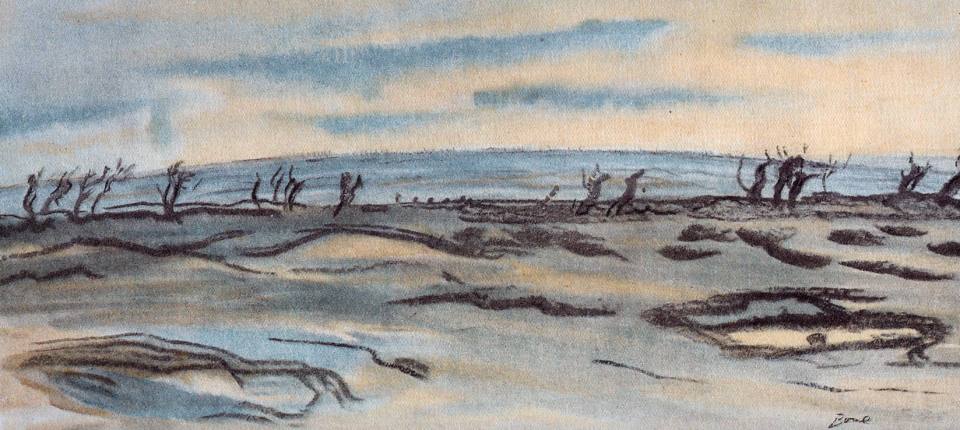 On 10th March the Battalion marched to the front line trenches and relieved the 125th French Regiment in trenches opposite La Folie Farm on Vimy Ridge, which at this stage of the War could only be recognised as a dirt heap and the presence of a few scattered trees.
On 10th March the Battalion marched to the front line trenches and relieved the 125th French Regiment in trenches opposite La Folie Farm on Vimy Ridge, which at this stage of the War could only be recognised as a dirt heap and the presence of a few scattered trees.
The 6th Sherwood Foresters occupied trenches in the right sub sector alternating with the 5th Sherwood Foresters, whilst the 7th Sherwood Foresters and 8th Sherwood Foresters alternated trench duty in the left sub sector trenches.
The portion of front line assigned to the Brigade ran from Souchez in the North to Neuville St. Vast in the South. The 138th Brigade occupied trenches to the left of the 139th Brigade, whilst the 137th Brigade was on the right of the Sherwood Foresters. The French 50th Regiment were on the right flank of the 46th Division. The Battalion frontage itself was 700 yards long.
 This whole area had seen heavy fighting in September 1915 as the French attempted to push the Germans off Vimy Ridge and what greeted the men of the 46th Division was a scene of utter desolation with collapsed trenches, old barbed wire, mine craters, shell-holes and dead bodies everywhere.
This whole area had seen heavy fighting in September 1915 as the French attempted to push the Germans off Vimy Ridge and what greeted the men of the 46th Division was a scene of utter desolation with collapsed trenches, old barbed wire, mine craters, shell-holes and dead bodies everywhere.
Like most of Flanders the ground was an absolute quagmire and for much of the time the men found themselves up to their knees in mud. The only respite was on those days when the water was frozen, but even this could prove to be an obstacle and often required cracking during trench patrolling.
 The front line trenches were now located at the base of the ridge and the Germans enjoyed good observation over the whole area. At this point of the front line the German trenches were very close, often no more than 100 yards away, whilst bombing posts in saps were even closer (often only 10 to 15 yards apart).
The front line trenches were now located at the base of the ridge and the Germans enjoyed good observation over the whole area. At this point of the front line the German trenches were very close, often no more than 100 yards away, whilst bombing posts in saps were even closer (often only 10 to 15 yards apart).
The communication trenches leading to the front, which were built by the French earlier in the War, were practically straight and there had been no attempt at traversing. This made movement along them very dangerous at any time. Many of the communication trenches were impassable and the French had laid duck-boards across the open ground.
Behind the front line trenches, and to the west of the Route de Bethune, were a number of deep dug-outs, some of which could hold several hundred men. However, the dugs-outs in the front line trenches were mere shelters cut into the side of trench walls.
 One of the first tasks for the Sherwood Foresters was to repair and strengthen the front line and reserve trenches. In some instances the craters of large mines, exploded by the Germans, enfiladed the front line trenches. For example the 7th Sherwood Foresters soon found themselves manning Bertrand trench, which had been cut in two by a German mine exploded only 20 days previously. The opposing sides had strengthened their sap heads and constant bombing attacks were undertaken by both sides. To help protect the men in the front line trenches and forward saps from German ‘tater mashes’ netting was erected.
One of the first tasks for the Sherwood Foresters was to repair and strengthen the front line and reserve trenches. In some instances the craters of large mines, exploded by the Germans, enfiladed the front line trenches. For example the 7th Sherwood Foresters soon found themselves manning Bertrand trench, which had been cut in two by a German mine exploded only 20 days previously. The opposing sides had strengthened their sap heads and constant bombing attacks were undertaken by both sides. To help protect the men in the front line trenches and forward saps from German ‘tater mashes’ netting was erected.
Due to the positioning of mine galleries, many of the Companies decided to hold the front line with as few men as possible and often the Battalion scouts were required to man the furthermost trenches and listen for evidence of German mining.
During their time at Vimy Ridge the 139th Brigade suffered a lot of cases of “trench foot” and many of these men had to be sent out of the trenches and to the Casualty Clearing Stations for treatment. With a little bit of care most of the men recovered; however, those unfortunate enough to develop frost-bite often had to have their legs amputated.
 At this time the Battalion stores and transport lines were placed safely behind the front line at Capelle Fermont.
At this time the Battalion stores and transport lines were placed safely behind the front line at Capelle Fermont.
On the 17th March each Battalion was required to supply a draft of men for the Brigade Mining Section, which had been reconstituted to help the French miners who were very active in this sector. Fortunately a draft of 142 men from the 3/6th Sherwood Foresters had arrived as Reinforcements the previous day.
 These men formed the 6th Reinforcement, which had embarked from England on the 4th April and joined the North Midland Base Depot in Rouen. They proceeded to the 1/6th Battalion on the 16th April.
These men formed the 6th Reinforcement, which had embarked from England on the 4th April and joined the North Midland Base Depot in Rouen. They proceeded to the 1/6th Battalion on the 16th April.
On the 23rd March the Battalion were relieved by the 5th Sherwood Foresters and returned to their billets and hutments in Acq after a 12 day trench duty.
Casualties during this first tour of duty had been relatively light with only 4 men killed (or died of wounds), but a further 11 men wounded as recorded by Colonel Goodman.
 Battalion War Diary entry initialed by Colonel Goodman (WO/95/2694).
Battalion War Diary entry initialed by Colonel Goodman (WO/95/2694).
Two of the men killed on the 12th March were:-
- 1911 Pte. George Bailey a shoemaker from Stoney Middleton and 25 years old.

- 3339 Pte. Albert Renshaw a miner from Clowne and 24 years old. Albert was killed by a German grenade but his diary was retrieved by a comrade and returned to his sister, Miss H Renshaw [A Diary of Foreign Service by Simon and Robert Thornton. Stand To!, 58: April 2000].


Both George Bailey and Albert Renshaw are now buried next to each other in Cabaret Rouge British Cemetery; however, the plot number in which they are both buried indicates that their bodies were moved during the concentration of smaller cemeteries into Cabaret Rouge after the War.
For more information on this ‘lost cemetery’ see here.
Also fatally wounded was:-
-
2138 L/Cpl. Alfred Simpson, a belt stretcher from Chinley, who died of his wounds in the 1/2 Highland Field Ambulance and was buried in Aubigny Communal Cemetery Extension (Plot 1.A.1).


 Alfred was the first British Soldier to be buried in this Cemetery as the B.E.F. took over the area from the French Tenth Army.
Alfred was the first British Soldier to be buried in this Cemetery as the B.E.F. took over the area from the French Tenth Army.
 This Cemetery now contains the graves of 45 Officers and men from the 46th North Midland Division who died at the nearby Field Ambulances or Casualty Clearing Stations. The men are all buried consecutively in Plot I, Row A (Graves 1-65) and Row B (Graves 25, 32 & 48). The two Officers, Herbert Newland (4th Lincolnshire) and Gerald Smith (6th South Staffs) are buried next to each other in Plot V, which was reserved for Officers.
This Cemetery now contains the graves of 45 Officers and men from the 46th North Midland Division who died at the nearby Field Ambulances or Casualty Clearing Stations. The men are all buried consecutively in Plot I, Row A (Graves 1-65) and Row B (Graves 25, 32 & 48). The two Officers, Herbert Newland (4th Lincolnshire) and Gerald Smith (6th South Staffs) are buried next to each other in Plot V, which was reserved for Officers.
The full list of 46th North Midland Burials can be downloaded here Aubigny NMD.
Amongst the less seriously wounded were:-
- 1644 Dmr. James Chatterton a print worker from Birch Vale who received a GSW in the thigh and was transferred to England.
- 2744 Pte. Levi Cooper a lime kiln worker from Dove Holes.
- 2588 Pte. William Slack a quarryman from Tideswall who received a GSW in the back and was transferred to England.
On arriving in this sector the Brigade soon realised that the fire and support trenches were in a very poor state, in fact just before the Division had arrived in this sector, the Germans had attacked and pushed the French out of their immediate front line trenches.
Expecting another attack at any time the Sherwood Foresters at once set about repairing and strengthening the defensive works. During this time, 20 year old George Taylor from Shuttlewood was killed and like his colleagues who were killed the previous week he was buried in a nearby comrade’s cemetery at Mt. St. Eloi. His grave was later moved to Cabaret-Rouge after the War.
- 3140 Pte. George Taylor was aged 20 and was a miner from Bolsolver.
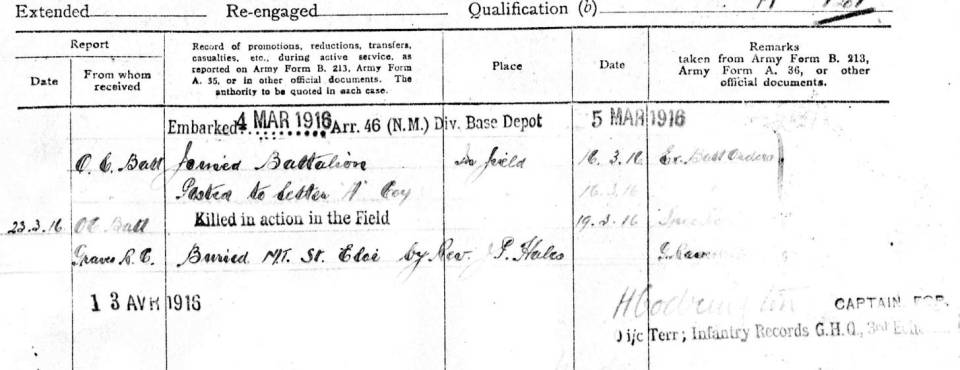 Army Form B. 103 “Casualty Form – Active Service” recording George’s burial at Mont St. Eloi by Reverand Hales. George had only been with the Battalion for 3 days.
Army Form B. 103 “Casualty Form – Active Service” recording George’s burial at Mont St. Eloi by Reverand Hales. George had only been with the Battalion for 3 days.
On the 23rd March “A” and “B” Companies, under Captains Evelyn Brownlow Johnson and Joseph Tolsen respectively, marched to the front line trenches from their billets in Acq for 6 hours work in the trenches.
When they arrived it transpired that the 5th Sherwood Foresters were attempting to occupy the nearer lip of a crater, formed by a mine that had been exploded earlier in the day, but had been driven back with a concerted bombing attack by the Germans.
At 11pm Lt.-Colonel Goodman was instructed to attack and occupy the near lip of the crater to retrieve the precarious situation. It was soon decided however that the situation was not favourable for an attack and it was postponed until the following evening.
 During the day a highly organised plan of attack was devised which included the use of trench mortars and longer range fire from the 3rd North Midland Brigade of Artillery. The artillery commenced firing at 6.30pm, but it was not until 11pm that the platoons of “B” Company began to make their way quietly up BIRKIN C.T. towards the lip of the crater in no-mans land.
During the day a highly organised plan of attack was devised which included the use of trench mortars and longer range fire from the 3rd North Midland Brigade of Artillery. The artillery commenced firing at 6.30pm, but it was not until 11pm that the platoons of “B” Company began to make their way quietly up BIRKIN C.T. towards the lip of the crater in no-mans land.
Each man was equipped with either a pick or shovel and wire netting rolled and already fixed to stakes to protect them from an attack by hand grenades. Their task was to dig a deep and narrow trench from the lip of the crater to the disconnected portion of the British front line. For protection each man carried two grenades and they were supported on either flank by grenadiers and Lewis gun teams placed in COMMON and DURRAND trenches.
Further back men of “A” Company and the grenadiers from the 8th Sherwood Foresters were in a retrenchment between GRANGE and BIRKIN trenches. The 3rd North Midland Brigade RFA continued to fire at intervals during the evening. The operation was a success and by dawn a trench 3 feet deep had been dug at the near lip of the crater linking up to existing trenches. It snowed intermittently during the night and the working conditions for the men must have been extremely difficult, but on the other hand not a single casualty was sustained. The digging parties joined the rest of Battalion in their billets during the day of the 27th March, but relieved the 5th Sherwood Foresters in the right sector trenches during the evening.
The Battalion were relieved by the 5th Sherwood Foresters on 3rd April and moved into billets in Acq.
The Battalion’s casualties for the previous 8 days trench duty had been 2 men killed and 4 wounded, with 2/Lts. FWA Stubbs and JE Barker slightly wounded at duty.
The two men killed were:-
- 3548 Albert Housley aged 20 and a grocers assistant from Ashbourne who was shot by a sniper. He was the son of Thomas and Sarah Ann Housley of Ashbourne in Derbyshire.
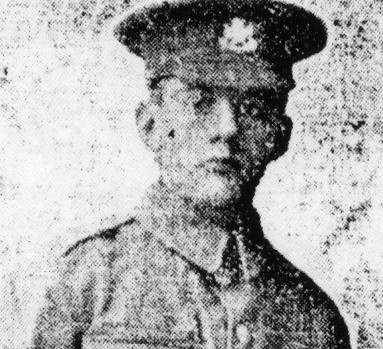
- 2448 Hilary Carlin aged 21 and a miner from Blackwell. He was the son of Joseph and Alice Carlin, of Beighton, Derbyshire.
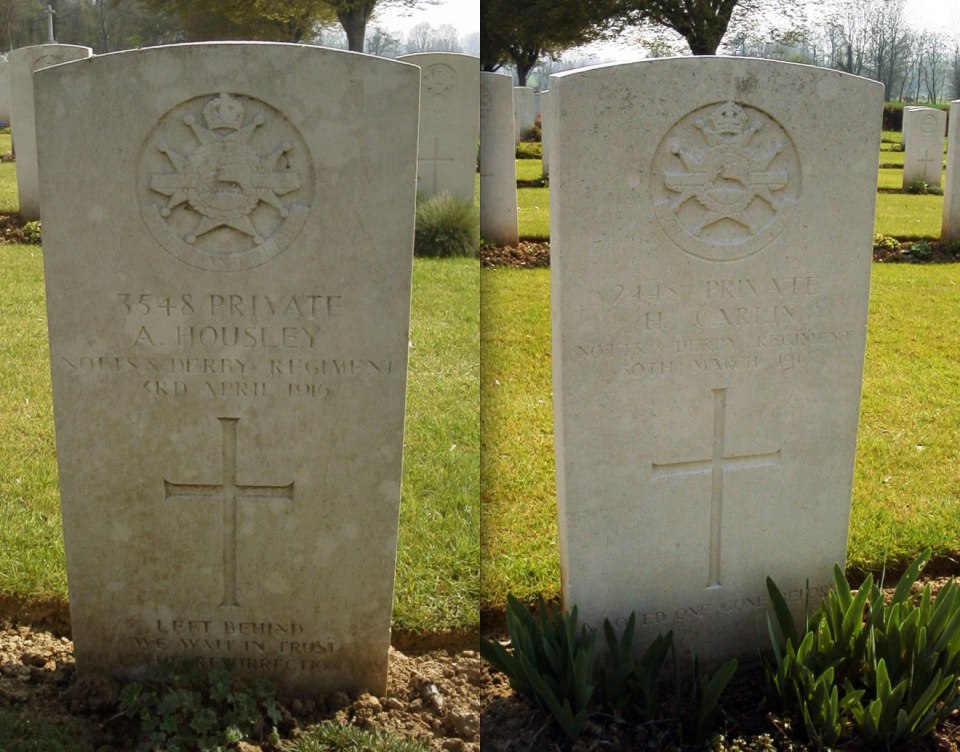 Both men are now buried in ECOIVRES MILITARY CEMETERY close to MONT-ST. ELOI.
Both men are now buried in ECOIVRES MILITARY CEMETERY close to MONT-ST. ELOI.
The wounded men were:-
- 4306 Pte. James Ball.
- 1710 Pte. Arthur Jodrell.
- 2368 Pte. Fred Nichols who suffered a GSW in the right leg and transferred to England.
- 2608 Pte. Leonard Pott who suffered a GSW in the left hand and transferred to England.
 On the last day of March a draft of 122 Other Ranks arrived at Capelle-Fermont from the 3/6th Battalion. These men were part the 7th Reinforcement that had embarked from England on the 18th March but did not officially join the unit until the 5th April.
On the last day of March a draft of 122 Other Ranks arrived at Capelle-Fermont from the 3/6th Battalion. These men were part the 7th Reinforcement that had embarked from England on the 18th March but did not officially join the unit until the 5th April.
Officers and Senior N.C.O.s at Capelle-Fermont in March 1916. Captain Hopkins and Lieutenant Broomhead are present.
Whilst in reserve at Acq several of the Battalion Officers and the whole of the Band were sent to either Divisional or Army Schools of training and Lt. Frederick W Hipkins with 5 men were sent on a one week Lewis Gun course at Camiers. The Lewis gun was a light machine gun developed in the United States in 1911 and nicknamed ‘the Belgian rattlesnake’ by German forces that came up against the weapon in 1914. The Lewis gun was formally adopted as the standard issue British Army machine gun towards the end of 1915 and initially each British Army Battalion had four Lewis guns. The Battalions of the 46th Division had received their Lewis Guns in Domqueur, whilst the Division re-assembled prior to the move to Vimy. Initially each Battalion had received two Lewis guns for instructional purposes. However, as the Sherwood Foresters Battalions started to take over the front line each trenches they were issued with up to eight guns.
On the 9th April the battalion relieved the 5th Sherwood Foresters and on the 10th April whilst in the front line trenches Privates 3562 Alfred Bailey and 3568 Leonard Twigge were killed in action and buried next to each other in Ecoivres Cemetery.

- 3562 Pte. Alfred Bailey aged 26 and a farm labourer from Tissington.
- 3568 Pte. Leonard Twigge aged 21 and a farm labourer from Parwich.
Alfred Bailey and Leonard Twigge both enlisted on 13th November 1914 with a group of farm labourers from the Ashbourne-Tissington-Parwich area of the South West Derbyshire Dales. Both men arrived in France on 28th May 1915 with the II Reinforcement and were placed with the No. 2 Entrenching Battalion on the 23rd July 1915. Leonard joined the 1/6th Battalion ‘in the field’ on the 17th August, whilst Alfred joined two months later on 16th October 1915.
 They were friends in peace time and comrades in death
They were friends in peace time and comrades in death
 The 46th (North Midland) Division took over the extension in March 1916 and the graves of their men are predominantly in Rows A to D of Plot I.
The 46th (North Midland) Division took over the extension in March 1916 and the graves of their men are predominantly in Rows A to D of Plot I.
Interestingly, the first North Midland burials were four Officers of the Division; three of whom died on the 18th March 1916. All four men are buried next to each other (I. D. 1-4).
In total there are 117 graves belonging to men of the 46th Division and all branches of the Services are represented including the Infantry Battalions, Royal Engineers and Artillery. This includes four men of the 1st/4th (Staffs) Battery of the 1st/3rd (North Midland) Brigade* who died on the 23rd April 1916.
Download the burial records for Ecoivres.
Also buried amongst the North Midlanders are three Sappers from the 182nd Tunnelling Company of the Royal Engineers who were very active in the area at that time.
War Diaries for these Companies are as follows:-
- 181 Tunnelling Company RE (Aug 1915 – Apr 1919) – WO 95/405
- 182 Tunnelling Company RE (Dec 1915 – May 1919) – WO 95/488
- 185 Company RE (Oct 1916 – May 1919) – WO 95/245
*RFA Brigades were formed of three, six-gun batteries [three of 18pdr Quick Firing (QF) field guns and one of 4.5″ howitzers] and one brigade of four 4.5″ howitzer batteries. This Battery was to become “A” Battery (4th Staffordshire) of the 232nd Brigade R.F.A. (3rd North Midland) Commanded by Maj. F Meynell:-
- A Battery (4th Staffordshire)
- B Battery (5th Staffordshire)
- C Battery (6th Staffordshire)
- D Howitzer Battery (2nd Derbyshire)
WO 95/2674/2 (Jan 1915 – Feb 1917)
 During the night of the 16/17 April the French Army Sappers exploded two mines at the head of Grange C.T. at 11.55pm and at the head Birkin C.T. at 11.59pm. Operation Orders French Mine 16 April 1916.
During the night of the 16/17 April the French Army Sappers exploded two mines at the head of Grange C.T. at 11.55pm and at the head Birkin C.T. at 11.59pm. Operation Orders French Mine 16 April 1916.
2/Lt William Harold Holderness, the Battalion Interpreter, was killed and a further 4 men were wounded, one of whom, 4536 Arthur Brown, later died and both men are buried with their comrades in Ecoivres Cemetery.
- 2/Lt William Holderness aged 34 and was an Engineer living in Paris.
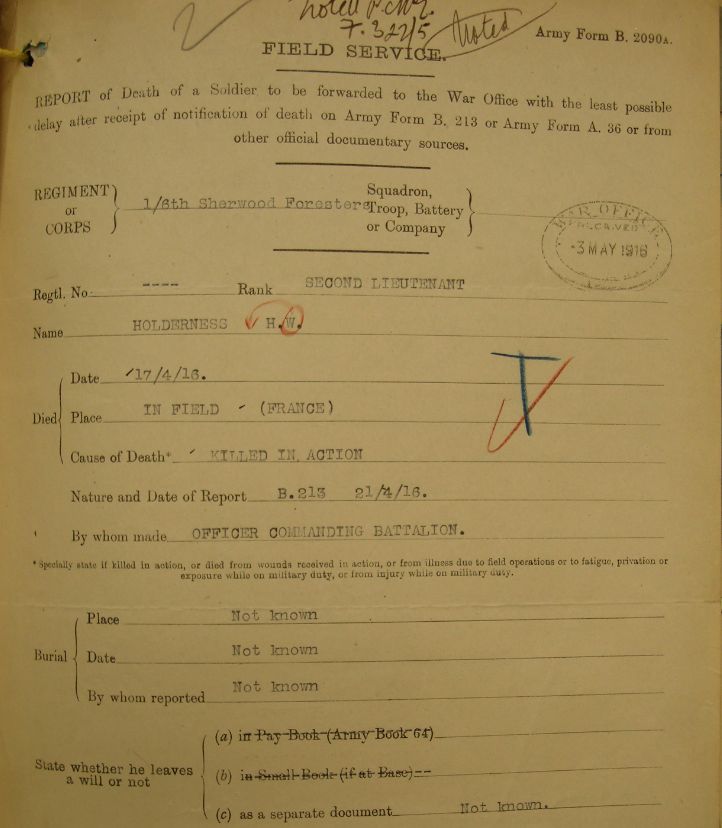
- 4536 Pte. Arthur Brown aged 19 and a weaver from Matlock.
During the evening of the 17th April the Battalion were relieved by the 5th Sherwood Foresters and returned to their billets in Acq.
During this trench tour, in addition to the casualties incurred by the mine explosion, the Battalion suffered 2 men killed and 13 men wounded; 2 of who later died of their wounds at the casualty clearing station in Aubigny:-
- 3835 Pte William Slack aged 21 and a labourer from Chesterfield.
- 3632 Pte. Edward Blood aged 21 and a miner from Bolsover.
 William and Edward died of their wounds in the 30th Casualty Clearing Station and are buried close to each other in Plot 1 A of Aubigny Communal Cemetery Extension (graves 36 and 39).
William and Edward died of their wounds in the 30th Casualty Clearing Station and are buried close to each other in Plot 1 A of Aubigny Communal Cemetery Extension (graves 36 and 39).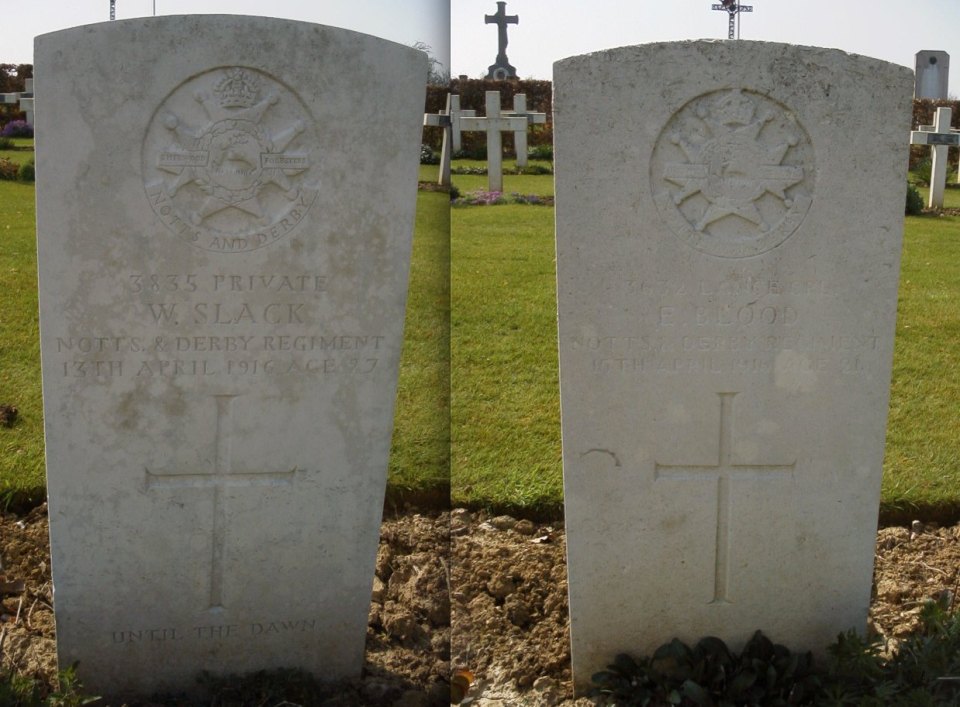
The other wounded men were:-
- 3429 Pte. John James Dykes a farm labourer from Hulland Ward and suffered a GSW in left leg and transferred to England.
- 4565 Pte. John William Fletcher.
- 4487 Pte. George Henry Smith a cook from Ashbourne and suffered GSW in legas and face and transferred to England and discharged.
- 4502 Pte. Joseph Riley.
- 1992 Pte. Herbert William Hunt a miner from Pilsely and suffered a GSW in face, eye and arm and transferred to England.
- 3212 Pte. Ernest Hutchinson.
- 2171 Pte. Ernest John Mellor a farm labourer from Clifton.
- 3667 Pte. Stephen Self a wool worker from Matlock Bath.
- 3127 Pte. Percy Holford a brass worker from Rotherham.
- 2053 Birt Birley a quarryman from Bakewell and suffered a GSW in head and transferred to England.
- 1995 Pte. Joseph Footitt was missing in action during the explosion of a German mine on the .
On the 19th the Battalion moved to new billets with HQ, “C” and “D” Companies occupying Billets in Marueuil, whilst “A” and “B” Companies occupied dug-outs at Anzin and Roclincourt. Altogether the Battalion was spread over an area of more than 5 km. From here the Battalion relieved the 3rd Worcesters, who took over the recently vacated Billets in Acq, and for the next 10 days the Battalion provided mining fatigues for the 181st and 185th Tunneling Companies of Royal Engineers on the 51st (Highland Division) Front [vi].
After being relieved by the 4th Lincolns the Battalion marched to billets in Penin on 29th April and Lt-Col.- Goodman took temporary command of the 139th Brigade due to the absence on leave of Brig-Gen.- Shipley.
At this time it was recorded in the War Diary that the Battalion were issued with 416 steel helmets. It should be noted at this point in the narrative that the vast majority of the British Expeditionary Force that went to France in 1914 and 1915 wore the soft-peaked cloth cap. However this offered no effective protection to sniper bullets or flying shrapnel and many of the casualties in 1914-15 were due to head wounds. This so concerned the War Office that by the summer of 1915 trials were underway of a forged steel helmet designed by John Brodie, and by the following year over one million helmets had been delivered to the Army. The Battle of St Elio in April saw the first widespread use of the ‘shrapnel’ helmet by the British Army.
On the 6th May the 6th Sherwood Foresters marched to billets at Ivergny. During their six weeks below Vimy Ridge the Battalion had suffered relatively light casualties compared to their previous trench duties; however they still left 12 of their comrades buried in the local cemeteries.

